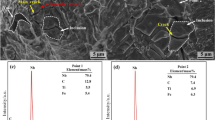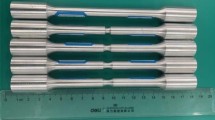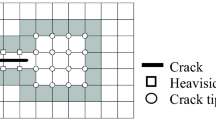Abstract
The influence of the MnS plastic inclusion on the accumulation of internal damage was considered, and the Gurson–Tvergaard–Needleman (GTN) model was calibrated based on the finite element inverse method and image analysis method using ABAQUS and GTN models. The modified GTN damage model was used to simulate the initiation and propagation of cracks in an as-cast 304 stainless steel with MnS inclusions at 900 °C. The simulation results agreed well with the experimental results, indicating that the model can be effectively applied to examine the high-temperature fracture behavior of MnS inclusions. The simulation and high-temperature tensile test results revealed that MnS inclusions increased the number of holes initiation and the probability of hole polymerization, reduced the crack propagation resistance, accelerated the occurrence of material fracture behavior, and were closely related to the stress state at high temperatures. When the stress triaxiality was low, the plastic strain in the metal matrix was high, and the MnS plastic inclusions accelerated the polymerization of the pores, making metal fracture failure more likely. On the other hand, when the stress triaxiality was high, the stress state in the metal matrix was biased to the tensile state, the plastic strain in the metal matrix was low, and the influence of MnS plastic inclusions on the fracture behavior was not evident.











Similar content being viewed by others
References
M. Daly, T.L. Burnett, E.J. Pickering, O.C.G. Tuck, F. Léonard, R. Kelley, P.J. Withers, A.H. Sherry, Acta Mater. 130 (2017) 56–68.
Y. Neishi, T. Makino, N. Matsui, H. Matsumoto, M. Higashida, H. Ambai, Metall. Mater. Trans. A 44 (2013) 2131–2140.
S.K. Paul, A. Ray, J. Mater. Eng. Perform. 6 (1997) 27–34.
R.S. Qi, M. Jin, X.G. Liu, B.F. Guo, J. Iron Steel Res. Int. 23 (2016) 531–538.
L.Y. Wang, L. Li, J. Mater. Eng. Perform. 26 (2017) 3831–3838.
M. Abbasi, M.A. Shafaat, M. Ketabchi, D.F. Haghshenas, M. Abbasi, J. Mech. Sci. Technol. 26 (2012) 345–352.
Y.R. Oh, H.S. Nam, Y.J. Kim, N. Miura, Int. J. Press. Vessels Pip. 159 (2018) 35–44.
S. Gatea, H. Ou, B. Lu, G. McCartney, Eng. Fract. Mech. 186 (2017) 59–79.
L. Malcher, F.M.A. Pires, J.M.A.C. de Sá, Int. J. Plast. 54 (2014) 193–228.
G. Perrin, J.B. Leblond, Int. J. Plast. 16 (2000) 91–120.
V. Tvergaard, J. Mech. Phys. Solids 44 (1996) 1237–1253.
J. Zhang, H.C. Kwon, H.Y. Kim, S.M. Byon, H.D. Park, Y.T. Im, J. Mater. Process. Technol. 162 (2005) 447–453.
R. Kiran, K. Khandelwal, Fatigue Fract. Eng. Mater. Struct. 37 (2014) 171–183.
M.S. Joun, J.G. Eom, M.C. Lee, Mech. Mater. 40 (2008) 586–593.
Y. Zhu, M.D. Engelhardt, R. Kiran, Eng. Fract. Mech. 199 (2018) 410–437.
M. Springmann, M. Kuna, Comput. Mater. Sci. 33 (2005) 501–509.
C.K. Oh, Y.J. Kim, J.H. Baek, Y.P. Kim, W. Kim, Int. J. Mech. Sci. 49 (2007) 1399–1412.
D. Steglich, W. Brocks, Comput. Mater. Sci. 9 (1997) 7–17.
S. Katani, F. Madadi, M. Atapour, S.Z. Rad, Mater. Des. 49 (2013) 1016–1021.
W.B. Lievers, A.K. Pilkey, D.J. Lloyd, Acta Mater. 52 (2004) 3001–3007.
T. Pardoen, J.W. Hutchinson, J. Mech. Phys. Solids 48 (2000) 2467–2512.
M. Khelifa, M. Oudjene, A. Khennane, Comput. Struct. 85 (2007) 205–212.
Y.M. Huang, K.H. Chien, J. Mater. Process. Technol. 117 (2001) 43–51.
P. Teixeira, A.D. Santos, F.M.A. Pires, J. Mater. Process. Technol. 177 (2006) 278–281.
Acknowledgements
This research was supported by the National Natural Science Foundation of China (Grant Nos. 51575475 and 51675465).
Author information
Authors and Affiliations
Corresponding author
Rights and permissions
About this article
Cite this article
Liu, Xg., Wang, C., Deng, Qf. et al. High-temperature fracture behavior of MnS inclusions based on GTN model. J. Iron Steel Res. Int. 26, 941–952 (2019). https://doi.org/10.1007/s42243-018-0202-4
Received:
Revised:
Accepted:
Published:
Issue Date:
DOI: https://doi.org/10.1007/s42243-018-0202-4




